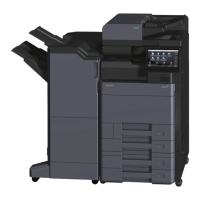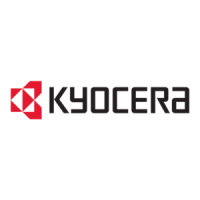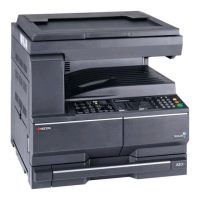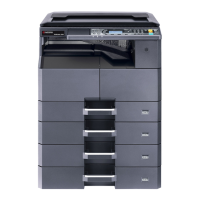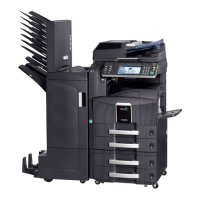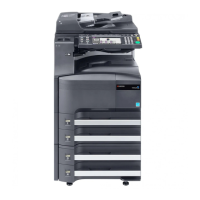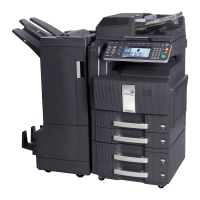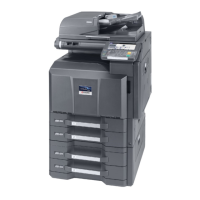Do you have a question about the Kyocera TASKalfa 6550ci and is the answer not in the manual?
Identifies the components and functions of the machine's operation panel.
Provides an overview of the machine's parts and their labels.
Provides instructions for connecting LAN and USB cables to the machine.
Details the procedure for powering the machine on and off.
Guides users through configuring network settings for LAN connectivity.
Explains how to install printer drivers and other necessary software on a PC.
Provides instructions for loading paper into various trays and feeders.
Details how to place originals on the platen or in the document processor.
Describes how to log in and out of the machine using user authentication.
Explains the fundamental steps for making copies, including quantity and paper selection.
Covers the basic procedure for sending scanned documents via various methods.
Guides users on storing, retrieving, and managing documents in custom and job boxes.
Describes how to cancel printing or sending jobs that are in progress or waiting.
Allows users to specify the size of the original documents for scanning.
Guides users on selecting the appropriate paper source for copying jobs.
Explains how to handle originals of different sizes in a batch scan.
Explains how to create booklets from originals using folding and stapling options.
A printing mode to save toner by producing lighter copies.
Adjusts the strength of cyan, magenta, yellow, and black for fine hue adjustments.
Provides pre-set image adjustments for vivid or muted images.
Adjusts the sharpness of image outlines for clearer copies.
Allows scanning large numbers of originals in separate batches.
Sends an e-mail notification upon job completion.
Suspends a current job to give priority to another job.
Enables making additional copies after a job is completed.
Guides users on printing documents from various software applications.
Explains how to use job boxes for storing and printing jobs.
Allows selection of the original size for scanning documents.
Specifies the size of the scanned image to be sent.
Selects the file format (PDF, TIFF, JPEG, XPS) for sending scanned images.
Restricts access to PDF files by assigning a secure password.
Guides users on creating, editing, and managing custom document boxes.
Details how to print documents stored in custom boxes.
Explains how to store scanned files onto a USB memory device.
Provides instructions for safely removing USB memory.
Allows users to view the status of jobs being processed or waiting.
Provides information on completed jobs and their history.
Explains how to pause and resume printing jobs.
Describes how to cancel print or send jobs.
Suspends a current job to give priority to another job.
Displays current levels of toner, paper, and staples.
Allows configuration and status checking of connected devices and lines.
Groups general machine settings like language, sound, and screen defaults.
Configures default printer settings like emulation, color settings, and duplex.
Provides access to settings for adjusting print quality and performing maintenance.
Configures various network settings like host name and TCP/IP.
Manages settings related to data security and sanitization.
Lists and manages optional applications installed on the machine.
Specifies how user access is administered via login and password.
Manages copy/print counts by assigning IDs to accounts.
Covers procedures for routine maintenance, including toner replacement.
Provides instructions for cleaning various machine parts for optimal output quality.
Offers guidelines for identifying and resolving common machine problems.
Explains how to handle specific error messages displayed on the touch panel.
Provides step-by-step instructions for removing paper jams from different locations.
Identifies the components and functions of the machine's operation panel.
Provides an overview of the machine's parts and their labels.
Provides instructions for connecting LAN and USB cables to the machine.
Details the procedure for powering the machine on and off.
Guides users through configuring network settings for LAN connectivity.
Explains how to install printer drivers and other necessary software on a PC.
Provides instructions for loading paper into various trays and feeders.
Details how to place originals on the platen or in the document processor.
Describes how to log in and out of the machine using user authentication.
Explains the fundamental steps for making copies, including quantity and paper selection.
Covers the basic procedure for sending scanned documents via various methods.
Guides users on storing, retrieving, and managing documents in custom and job boxes.
Describes how to cancel printing or sending jobs that are in progress or waiting.
Allows users to specify the size of the original documents for scanning.
Guides users on selecting the appropriate paper source for copying jobs.
Explains how to handle originals of different sizes in a batch scan.
Explains how to create booklets from originals using folding and stapling options.
A printing mode to save toner by producing lighter copies.
Adjusts the strength of cyan, magenta, yellow, and black for fine hue adjustments.
Provides pre-set image adjustments for vivid or muted images.
Adjusts the sharpness of image outlines for clearer copies.
Allows scanning large numbers of originals in separate batches.
Sends an e-mail notification upon job completion.
Suspends a current job to give priority to another job.
Enables making additional copies after a job is completed.
Guides users on printing documents from various software applications.
Explains how to use job boxes for storing and printing jobs.
Allows selection of the original size for scanning documents.
Specifies the size of the scanned image to be sent.
Selects the file format (PDF, TIFF, JPEG, XPS) for sending scanned images.
Restricts access to PDF files by assigning a secure password.
Guides users on creating, editing, and managing custom document boxes.
Details how to print documents stored in custom boxes.
Explains how to store scanned files onto a USB memory device.
Provides instructions for safely removing USB memory.
Allows users to view the status of jobs being processed or waiting.
Provides information on completed jobs and their history.
Explains how to pause and resume printing jobs.
Describes how to cancel print or send jobs.
Suspends a current job to give priority to another job.
Displays current levels of toner, paper, and staples.
Allows configuration and status checking of connected devices and lines.
Groups general machine settings like language, sound, and screen defaults.
Configures default printer settings like emulation, color settings, and duplex.
Provides access to settings for adjusting print quality and performing maintenance.
Configures various network settings like host name and TCP/IP.
Manages settings related to data security and sanitization.
Lists and manages optional applications installed on the machine.
Specifies how user access is administered via login and password.
Manages copy/print counts by assigning IDs to accounts.
Covers procedures for routine maintenance, including toner replacement.
Provides instructions for cleaning various machine parts for optimal output quality.
Offers guidelines for identifying and resolving common machine problems.
Explains how to handle specific error messages displayed on the touch panel.
Provides step-by-step instructions for removing paper jams from different locations.
| Network ready | Yes |
|---|---|
| Fax compatibility | ITU-T G3 |
| Dimensions (WxDxH) | 1039 x 801 x 1347 mm |
| All-in-one functions | Copy, Fax, Print, Scan |
| Connectivity technology | Wired |
| Color all-in-one functions | copy, fax, print, scan |
| DVD/CD printing | No |
| Print technology | Laser |
| Duplex printing mode | Auto |
| Time to first page (black, normal) | 5.4 s |
| Time to first page (color, normal) | 6.2 s |
| Print speed (black, normal quality, A3) | 32 ppm |
| Print speed (black, normal quality, A4/US Letter) | 65 ppm |
| Printing colors | Black, Cyan, Magenta, Yellow |
| Maximum duty cycle | - pages per month |
| Number of print cartridges | 4 |
| Page description languages | Microsoft XPS, PCL 5c, PCL 6, PCL XL |
| Copier resize | 25 - 400 % |
| Maximum number of copies | 999 copies |
| N-in-1 copy function (N=) | 2, 4 |
| Scan to | E-mail, FTP, OCR, USB |
| Grayscale levels | 256 |
| Maximum scan area | A3 (297 x 420) mm |
| Scan speed (black) | 200 ppm |
| Scan speed (color) | 150 ppm |
| Image formats supported | JPG, TIF |
| Fax memory | 120 MB |
| Modem speed | 33.6 Kbit/s |
| Fax coding methods | JBIG, MH, MMR (Fax coding method), MR |
| Fax transmission speed | 3 sec/page |
| Paper input type | Paper tray |
| Total input capacity | 4150 sheets |
| Total output capacity | 420 sheets |
| Maximum input capacity | 7650 sheets |
| Multi-Purpose tray input capacity | 150 sheets |
| Maximum print size | 297 x 420 mm |
| Duplex media weight | 60 - 256 g/m² |
| Paper tray media types | Plain paper |
| Paper tray media weight | 60 - 220 g/m² |
| ISO A-series sizes (A0...A9) | A3, A4 |
| Maximum ISO A-series paper size | A3 |
| Multi-Purpose Tray media weight | 60 - 300 g/m² |
| Display | LCD |
| Market positioning | Business |
| Standard interfaces | Ethernet, USB 2.0 |
| USB 2.0 ports quantity | 2 |
| Processor model | 750GL |
| Processor family | PowerPC |
| Processor frequency | 916 MHz |
| Compatible memory cards | CF |
| Internal storage capacity | 320 GB |
| Sound power level (standby) | 58 dB |
| Sound pressure level (printing) | 75 dB |
| AC input voltage | 100 - 240 V |
| AC input frequency | 50 - 60 Hz |
| Power consumption (standby) | 330 W |
| Power consumption (PowerSave) | 23 W |
| Power consumption (average operating) | 1570 W |
| Sustainability certificates | ENERGY STAR |
| Certification | TÜV/GS, CE, RoHS |


